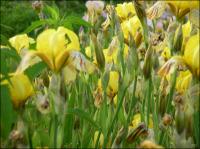Description
ARCHIVED
Note: This is a plant not currently for sale. This is an archive page preserved for informational use.
Clear yellow standards with maroon striped-dashed falls, blooms in mid-season
Clear yellow standards with maroon striped-dashed falls
ARCHIVED
Note: This is a plant not currently for sale. This is an archive page preserved for informational use.
Clear yellow standards with maroon striped-dashed falls, blooms in mid-season
ARCHIVED
Note: This is a plant not currently for sale. This is an archive page preserved for informational use.
Adorable dwarf shrub bearing orange-red blooms in July and August then tiny, edible pomegranates. Where not hardy makes good container plant and bonsai.
Size: 2-4’ x 2-4’
Care: sun to part shade in moist well-drained to well-drained soil
Native: Europe to Himalayas
“The plants will bear miniature fruit if grown in areas with year-round temperatures that rarely fall below 40° F. To grow indoors, moderate night-time temperatures should be given (50° to 60° F). Keep at 40° to 45° F in winter until new growth appears. In the growing period, keep moderately moist. Water sparingly from August on. This plant requires good drainage. Plants will bear fruit indoors if grown in a sunny exposure.” Issour Botanic Garden. It is deciduous and may lose its leaves.
This dwarf described in 1803.
ARCHIVED
Note: This is a plant not currently for sale. This is an archive page preserved for informational use.
Lavender daisies from late-summer into fall, valuable for long-blooming and short size
Size: 6-10” x 15-24” Care: sun in well-drained, to moist well-drained, acidic soil
Native: NW US, Alaska, Canada, Arctic & Siberia
Wildlife Value: attracts butterflies
Collected by German plant hunter Johann Gmelin in Siberia before 1753
ARCHIVED
Note: This is a plant not currently for sale. This is an archive page preserved for informational use.
Pale pink “pussy-toe”, resembling the pads of a kitten’s foot, flowers in early summer, great silvery-gray foliage, good groundcover and rock garden plant.
Size: 2” x 18”
Care: full sun in well-drained soil, drought tolerant
Native: Temperate areas worldwide
Antennaria from the Latin antenna originally referring to the mast of a sailboat. Part of the flower supposedly resembles a butterfly’s antennae. Historically used for medicine as an astringent, a cough remedy and to break fever. First described by German physician and botanical author Leonhard Fuchs (1501-1566). Gertrude Jekyll (1848-1931), mother of the mixed perennial border, planted this in her own rock garden at Munstead Wood and in the Sundial Garden at Pednor House in Buckinghamshire. The pink version, A. dioica rosea, collected in the Rocky Mountains by C.C. Parry before 1860.
ARCHIVED
Note: This is a plant not currently for sale. This is an archive page preserved for informational use.
Covered with petite double white daisies with golden stamens blooming for months –late summer-fall.
Size: 2-3’ x 1-2’
Care: sun to part shade in well-drained to moist well-drained soil
Native: Japan
Awards: Georgia Gold Medal 1998
Taxonomists had trouble naming this one. First described in French Journal Nouv. Arch. Mus. Hist. Nat. in 1882. A favorite flower of the late garden writer Elizabeth Lawrence who traced it to the grounds of the old Oxford Orphanage in Oxford NC. (1942)

